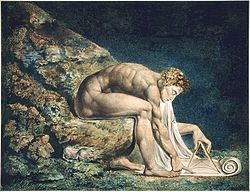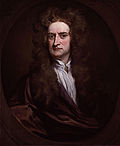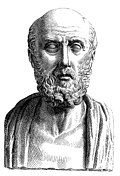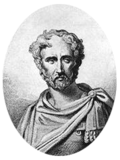Portal:History of science
The History of Science Portal
The history of science covers the development of science from ancient times to the present. It encompasses all three major branches of science: natural, social, and formal. Protoscience, early sciences, and natural philosophies such as alchemy and astrology that existed during the Bronze Age, Iron Age, classical antiquity and the Middle Ages, declined during the early modern period after the establishment of formal disciplines of science in the Age of Enlightenment.
Science's earliest roots can be traced to Ancient Egypt and Mesopotamia around 3000 to 1200 BCE. These civilizations' contributions to mathematics, astronomy, and medicine influenced later Greek natural philosophy of classical antiquity, wherein formal attempts were made to provide explanations of events in the physical world based on natural causes. After the fall of the Western Roman Empire, knowledge of Greek conceptions of the world deteriorated in Latin-speaking Western Europe during the early centuries (400 to 1000 CE) of the Middle Ages, but continued to thrive in the Greek-speaking Byzantine Empire. Aided by translations of Greek texts, the Hellenistic worldview was preserved and absorbed into the Arabic-speaking Muslim world during the Islamic Golden Age. The recovery and assimilation of Greek works and Islamic inquiries into Western Europe from the 10th to 13th century revived the learning of natural philosophy in the West. Traditions of early science were also developed in ancient India and separately in ancient China, the Chinese model having influenced Vietnam, Korea and Japan before Western exploration. Among the Pre-Columbian peoples of Mesoamerica, the Zapotec civilization established their first known traditions of astronomy and mathematics for producing calendars, followed by other civilizations such as the Maya.
Natural philosophy was transformed during the Scientific Revolution in 16th- to 17th-century Europe, as new ideas and discoveries departed from previous Greek conceptions and traditions. The New Science that emerged was more mechanistic in its worldview, more integrated with mathematics, and more reliable and open as its knowledge was based on a newly defined scientific method. More "revolutions" in subsequent centuries soon followed. The chemical revolution of the 18th century, for instance, introduced new quantitative methods and measurements for chemistry. In the 19th century, new perspectives regarding the conservation of energy, age of Earth, and evolution came into focus. And in the 20th century, new discoveries in genetics and physics laid the foundations for new sub disciplines such as molecular biology and particle physics. Moreover, industrial and military concerns as well as the increasing complexity of new research endeavors ushered in the era of "big science," particularly after World War II. (Full article...)
Selected article -

The Strategic Defense Initiative (SDI), derisively nicknamed the Star Wars program, was a proposed missile defense system intended to protect the United States from attack by ballistic nuclear missiles. The program was announced in 1983, by President Ronald Reagan. Reagan called for a system that would render nuclear weapons obsolete, and to end the doctrine of mutual assured destruction (MAD), which he described as a "suicide pact". Elements of the program reemerged in 2019 under the Space Development Agency (SDA).
The Strategic Defense Initiative Organization (SDIO) was set up in 1984 within the US Department of Defense to oversee development. Advanced weapon concepts, including lasers, particle-beam weapons, and ground and space-based missile systems were studied, along with sensor, command and control, and computer systems needed to control a system consisting of hundreds of combat centers and satellites spanning the globe. The US held a significant advantage in advanced missile defense systems through decades of extensive research and testing. Several concepts, technologies and insights obtained were transferred to subsequent programs. Under SDIO's Innovative Sciences and Technology Office, investment was made in basic research at national laboratories, universities, and in industry. These programs have continued to be key sources of funding for research scientists in particle physics, supercomputing/computation, advanced materials, and other critical science and engineering disciplines. (Full article...)
Selected image

Poet and artist William Blake criticized Newton and like-minded philosophers such as Locke and Bacon for relying solely on reason.
Blake's 1795 print Newton is a demonstration of his opposition to the "single-vision" of scientific materialism: the great philosopher-scientist is shown utterly isolated in the depths of the ocean, his eyes (only one of which is visible) fixed on the compasses with which he draws on a scroll. His concentration is so fierce that he seems almost to become part of the rocks upon which he sits.
Did you know
...that in the history of paleontology, very few naturalists before the 17th century recognized fossils as the remains of living organisms?
...that on January 17, 2007, the Doomsday Clock of the Bulletin of the Atomic Scientists moved to "5 minutes from midnight" in part because of global climate change?
...that in 1835, Caroline Herschel and Mary Fairfax Somerville became the first women scientists to be elected to the Royal Astronomical Society?
Selected Biography -
Maria Goeppert Mayer (German: [maˈʁiːa ˈɡœpɐt ˈmaɪɐ] ⓘ; née Göppert; June 28, 1906 – February 20, 1972) was a German-American physicist who shared the 1963 Nobel Prize in Physics with J. Hans D. Jensen and Eugene Wigner. One half of the prize was awarded jointly to Goeppert Mayer and Jensen for their model of the atomic nucleus, known as the nuclear shell model. She was the second woman to win a Nobel Prize in Physics, the first being Marie Curie in 1903. In 1986, the Maria Goeppert-Mayer Award for early-career women physicists was established in her honor.
A graduate of the University of Göttingen, Goeppert Mayer wrote her doctoral thesis on the theory of possible two-photon absorption by atoms. At the time, the chances of experimentally verifying her thesis seemed remote, but the development of the laser in the 1960s later permitted this. Today, the unit for the two-photon absorption cross section is named the Goeppert Mayer (GM) unit. (Full article...)
Selected anniversaries
- 1006 - Supernova SN 1006, the brightest supernova in recorded history, appears in the constellation Lupus
- 1483 - Orbital calculations suggest that on this day, Pluto moved inside Neptune's orbit until July 23, 1503.
- 1492 - Spain gives Christopher Columbus his commission of exploration
- 1696 - Death of Robert Plot, British naturalist (b. 1640)
- 1723 - Birth of Mathurin Jacques Brisson, French naturalist (d. 1806)
- 1777 - Birth of Carl Friedrich Gauss, German mathematician (d. 1855)
- 1829 - Birth of Ferdinand von Hochstetter, Austrian geologist (d. 1884)
- 1875 - Death of Jean-Frédéric Waldeck, French explorer, lithographer, and cartographer (b. 1766)
- 1876 - Birth of Orso Mario Corbino, Italian physicist (d. 1937)
- 1916 - Birth of Claude Shannon, American engineer and mathematician (d. 2001)
Related portals
Topics
General images
Subcategories
Things you can do
Help out by participating in the History of Science Wikiproject (which also coordinates the histories of medicine, technology and philosophy of science) or join the discussion.
Associated Wikimedia
The following Wikimedia Foundation sister projects provide more on this subject:
 Commons
Commons
Free media repository Wikibooks
Wikibooks
Free textbooks and manuals Wikidata
Wikidata
Free knowledge base Wikinews
Wikinews
Free-content news Wikiquote
Wikiquote
Collection of quotations Wikisource
Wikisource
Free-content library Wikiversity
Wikiversity
Free learning tools Wiktionary
Wiktionary
Dictionary and thesaurus




- Random portal









































































